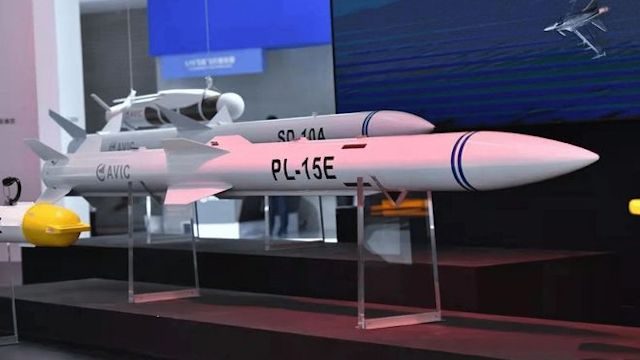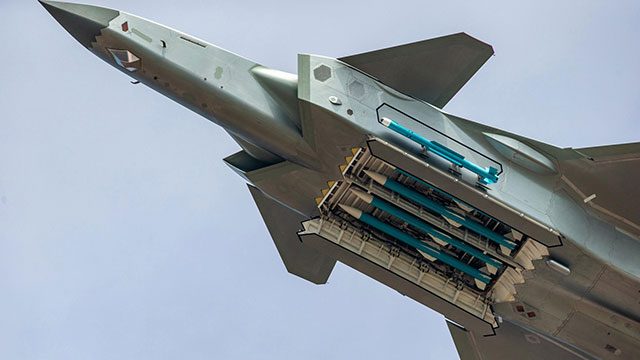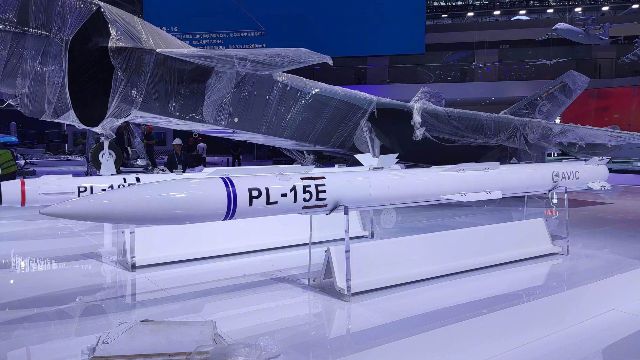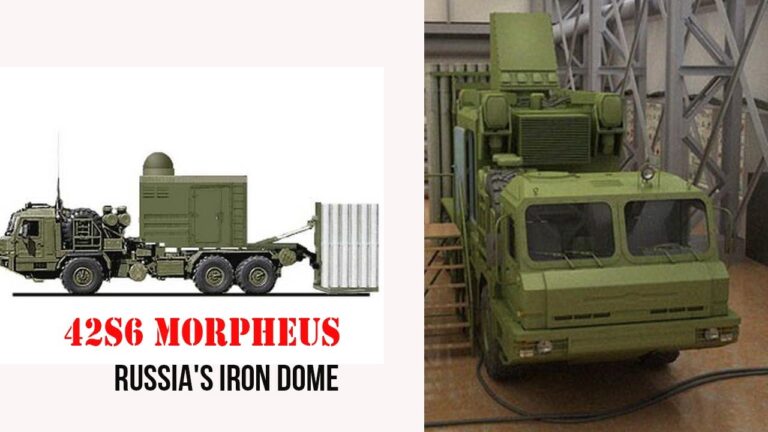
Chinese-BVR-missile-PL-15-air-to-air-missile
At the Zhuhai Airshow in southern China, a groundbreaking innovation in military technology was unveiled: the PL-15E missile, a new, export-ready variant of China’s long-range PL-15 air-to-air missile. This advanced missile incorporates a unique folding tail design that promises improved aerodynamics, stealth capabilities, and compatibility with stealth aircraft like the J-20 fighter jet. With its long-range capabilities and robust guidance systems, the PL-15E has the potential to revolutionise air-to-air combat.
This initial glimpse of China’s PL-15E air-to-air missile with a folding tail shows China’s goals to improve its air combat weapons, making the PL-15E a strong competitor against modern air-to-air missiles like the AIM-120D AMRAAM and the Russian R-37.
Design and Range: Long-Range Performance with a Folding Tail
The PL-15E boasts impressive beyond visual range (BVR) capabilities. While the original PL-15 model can reportedly engage targets up to 300 kilometres away, the export variant PL-15E is expected to have a maximum range of approximately 145 kilometres. Although the reduced range is still significant, it makes the PL-15E suitable for various operational environments and ensures compliance with international regulations on missile export restrictions.

The folding tail of the PL-15E allows it to be stored within the internal weapon bays of stealth aircraft, enhancing the carrier jet’s low radar signature. This innovative design not only supports the stealthy profile of the J-20 but also reduces drag, which is critical for preserving speed and manoeuvrability during combat operations. By reducing drag, the PL-15E missile enhances fuel efficiency and performance, particularly when stored externally.
Enhanced Compatibility and Flexibility in Deployment
One of the standout features of China’s PL-15E air-to-air missile with a folding tail is its compatibility across a range of aircraft types, enhancing its operational flexibility. This adaptability allows various aircraft, from stealth fighters to multi-role jets, to carry and deploy the PL-15E, simplifying logistical operations and expanding its potential deployment options.
The folding tail mechanism, however, introduces additional mechanical complexity. A failure in the deployment of the tails could compromise the missile’s functionality, particularly during high-speed manoeuvres. Nonetheless, Chinese engineers are likely to have integrated sophisticated guidance and control systems to mitigate these risks, ensuring stability and accuracy even in challenging conditions.
Technical Capabilities: Radar Homing and Fire-and-Forget Precision
The PL-15E’s advanced guidance systems incorporate active radar homing (ARH), enabling fire-and-forget capabilities. Once launched, the missile autonomously tracks its target, freeing the pilot to focus on other mission priorities.
The active radar guidance system can detect and track targets at distances beyond 50 kilometres, with some estimates suggesting target engagement ranges up to 100 kilometres. This long-range tracking and targeting capability places the PL-15E among the most advanced air-to-air missiles in active use today.
Solid Rocket Motor
With speeds nearing Mach 4, the missile is difficult to intercept, providing Chinese pilots with a considerable advantage in high-speed engagements. The two-stage solid rocket motor powers the missile, providing both high speed and a considerable range for striking distant threats.
Reports suggest that some versions of the missile may have an engine capable of adjusting its power, which would enhance its performance during different phases of flight, allowing it to maintain stability at various speeds and altitudes.
To ensure we match 100% accurate data for the specifications between China’s PL-15E, the U.S.’s AIM-120D AMRAAM, and Europe’s Meteor, here’s a fully reviewed table based on updated, reliable sources for each missile’s specifications:
| Feature | PL-15E (China) | AIM-120D AMRAAM (USA) | Meteor (Europe) |
|---|---|---|---|
| Introduction | 2024 (Export Version) | 2015 | 2016 |
| Primary Users | China, Pakistan (potential) | United States, multiple NATO allies | European NATO allies, Saudi Arabia |
| Maximum Range | Up to 145 km | Up to 160–180 km | Over 100 km (effective range up to 200 km) |
| Speed | Estimated Mach 4 | Mach 4+ | Mach 4+ |
| Guidance System | Active radar homing (ARH), Inertial | Active radar homing (ARH), Inertial | Active radar homing, Inertial + Data Link |
| Warhead | 20-30 kg | 18 kg High Explosive Fragmentation | ~10 kg High Explosive Fragmentation |
| Length | ~4 m | 3.7 m | 3.65 m |
| Diameter | 203 mm | 178 mm | 178 mm |
| Weight | ~200 kg | 152 kg | 190 kg |
| Engine Type | Dual-stage solid rocket motor | Solid rocket motor | Ramjet (throttleable ducted rocket) |
| Special Features | Folding tail for stealth storage | GPS-aided guidance, extended range | Throttleable ramjet for sustained speed and range |
| Target Lock Range | Beyond 50 km | Approximately 50 km | Around 60 km |
| “No Escape” Zone | High due to speed and guidance | Moderate, optimized for medium-range | Very large, due to sustained propulsion |
| Platforms | J-20, JF-17 Block III, J-10CE | F-15, F-16, F/A-18, F-22, F-35 | Eurofighter Typhoon, Gripen, Rafale |
Clarifications:
- PL-15E Range: The export version is capped at 145 km; the original PL-15 may reach up to 300 km in the domestic variant.
- AIM-120D AMRAAM: Extended-range AMRAAM variant, reported range maxes out at 160–180 km but is typically cited as effective within 120–150 km.
- Meteor: Effective range surpasses 100 km, with some sources suggesting it can exceed 200 km in optimal conditions due to its ramjet engine.
Aerodynamic and Structural Innovations
The first look at China’s PL-15E air-to-air missile with a folding tail underscores its meticulous design. Measuring around four metres in length and weighing roughly 200 kilograms, the missile is comparable to other long-range counterparts in size. Its structure includes small wings and tail stabilisers, contributing to the missile’s stability during supersonic flight.
The folding tail design, while beneficial for stealth and storage, also plays a key role in reducing the radar cross-section of both the missile and its carrier aircraft. This design helps stealth aircraft with PL-15E keep a low radar profile, making them more effective in situations where staying hidden is crucial.
Stealth and Strategic Superiority
The PL-15E’s design advancements allow it to seamlessly integrate with next-generation Chinese fighter jets. This missile isn’t only built to rival Western air-to-air systems; it’s engineered to exceed them. By adding a folding tail for stealth missions and a guidance system for accurate long-range attacks, the PL-15E presents a strong challenge to Western missiles like the AIM-120D and R-77.
China’s commitment to enhancing its air combat capabilities reflects its strategic objectives in the Pacific and beyond. As military competition in Asia intensifies, the development and deployment of cutting-edge missiles like the PL-15E could significantly influence the region’s military balance.
Engineering Challenges and Reliability Concerns
Despite its promising capabilities, the first look at China’s PL-15E air-to-air missile with a folding tail reveals a few potential challenges. The folding tail design, while innovative, adds mechanical complexity that could increase the risk of malfunctions. In high-stakes combat scenarios, any failure in tail deployment could impact the missile’s performance, particularly against fast-moving targets.
To counteract these potential issues, the PL-15E likely includes enhanced control systems that enable stability and reliability throughout its flight path. These engineering refinements would reduce the risk of malfunction, ensuring that the missile performs effectively even under intense operational pressures.

How Pakistan’s Air Force Could Gain the PL-15E Missile, Tilting Regional Balance
Pakistan’s Air Force (PAF) may soon acquire the PL-15E missile, a powerful asset that could shift regional dynamics. The PL-15E, China’s latest air-to-air missile, features an impressive range of up to 145 km and advanced radar-guided “fire-and-forget” capabilities. With a folding tail for stealth compatibility, it perfectly complements Pakistan’s JF-17 Block III and J-10CE fighters.
This advanced missile would enable PAF jets to engage targets over long distances, potentially outperforming regional defences. Such an acquisition underscores Pakistan-China military cooperation and could enhance Pakistan’s aerial strength, providing a strategic advantage in potential engagements.
China’s Strategic Edge with the PL-15E
The first look at China’s PL-15E air-to-air missile with a folding tail suggests that this weapon could redefine air-to-air combat strategies for China. With its long-range capability, advanced radar homing, and unique folding tail design, the PL-15E could provide Chinese pilots with a distinct tactical advantage over adversaries.
As China expands its military reach, the PL-15E missile represents a broader commitment to leading-edge technology in aerial warfare. By enabling Chinese jets to engage targets at considerable distances, the PL-15E’s capabilities present a formidable threat in any aerial engagement, positioning China as a powerful force in the region’s aerial defense strategy.
Conclusion: A Key Player in Modern Aerial Warfare
In conclusion, the first look at China’s PL-15E air-to-air missile with a folding tail showcases a sophisticated and formidable weapon that aligns with China’s broader military objectives. With its unique design features, including the folding tail and advanced radar systems, the PL-15E is set to enhance China’s air superiority. Although there may be engineering challenges, the capabilities of the PL-15E missile indicate a significant advancement in China’s aerial combat arsenal.
This first look at China’s PL-15E air-to-air missile with a folding tail highlights China’s ongoing innovations in missile technology. By refining features such as long-range engagement, fire-and-forget radar guidance, and stealth-enhancing designs, the PL-15E represents a bold step forward in modern military strategy and defense.
References
- Jane’s Defence Weekly, “Zhuhai Airshow 2024 Unveils New PL-15E Missile with Folding Tail Design”
- The Diplomat, “China’s PL-15E Missile Could Redefine Aerial Combat in the Pacific”
- Popular Science, “Analysis of the PL-15E Air-to-Air Missile: Folding Tail Technology and Operational Benefits”







